The first things we need to know is the air flow over the radiator.
In the old days folks weren't worried about safety, and radiators were big, and unshrouded, usually they were cooled by a
belt driven off the water pump.
Well Eurpoean folks took a longitudinal engine/tranny/driveshift/rear differential system and turned it sideways.
So the ideal had configuration wouldn't work as the water pumps were now on the left or right of the car and not
directly infront of the engine.
This lead to increased under the hood temps as the Transmission was now producing heat in the engine bay, and now
the invention of the electric radiator fan.
The Radiator fan was and is stupid. It has to be told when to turn on instead of being run by a direct fan.
So they added a Radiator fan switch to tell the radiator fan when to turn on.
Now your radiator fan is told to run, it doesn't care if your radiator cards are there or not. It is told to run.
It will pull air regardless of where the air comes from.
With the Radiator cards missing, it can and will pull air from the engine compartment back over the radiator, decreasing the effeciency
of the cooling ability.
Missing top card.
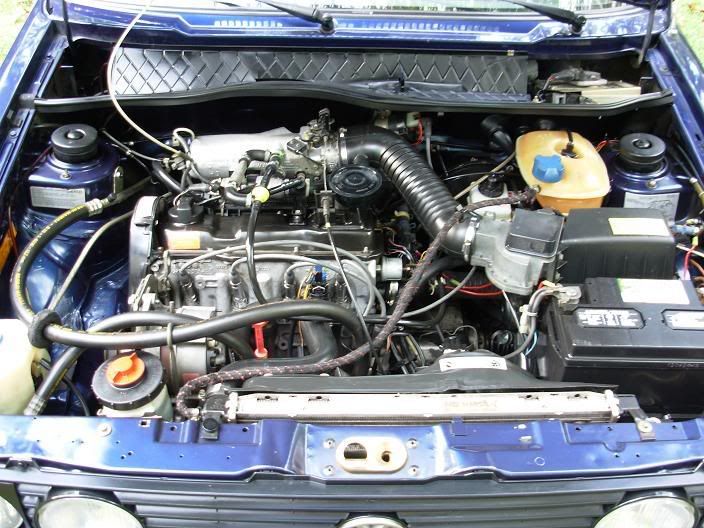
To prevent that, VW placed a shroud over the radiator to duct air over the radiator from the outside. These shrouds aren't a tight fit.
VW placed "cards" on the top, left and right of the radiator, the top one while preventing your tools and bolts from dropping infront of the radiator
also keeps the radiator pulling air from the Grille.
Brass top card:

You can make replacements out of sheet tin, brass, formica these are more durable as replacements.
The side baffles or cards also prevent that too, but usually are removed over the years as they get in the way.
If you watch the radiator fan work, you will see that on the Radiator shroud, there are 2 rubber flappers kept in place by nylon
clips with a stopper.
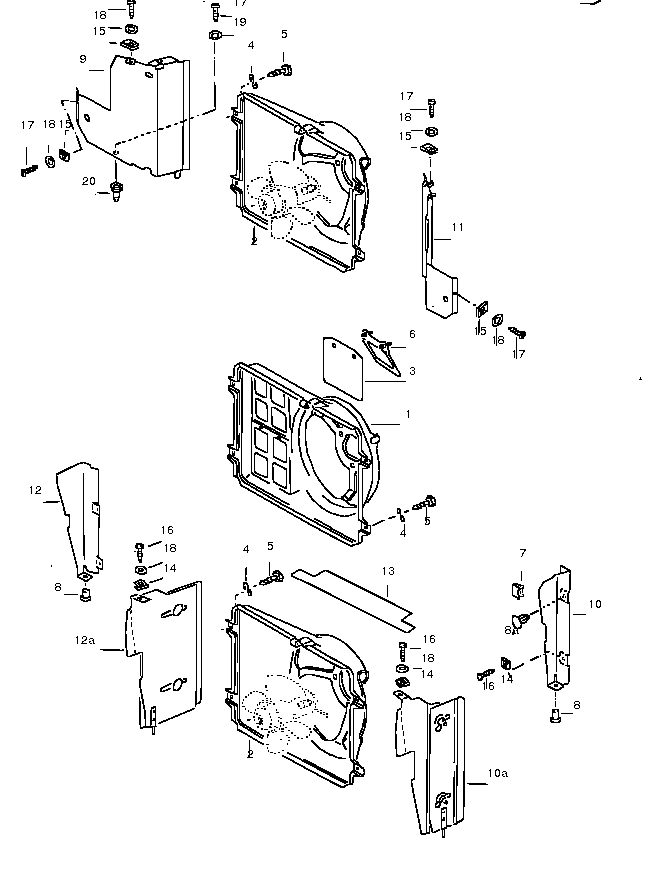
You have wondered what those are for? When the Radiator fan is running, they suck in to close the Shroud off and only allow air to pull from infront
or from the grille. When the radiator fan is off, they are allowed to free open, so that the radiator has air flow across the width of the core.
If they are missing then the Fan can draw engine air so much so that it can decrease the efficiency by half.
Now that we know that Radiator cards and flapper have a direct cause and effect, and if missing it is a bad thing,
lets move on to the Radiator Fans.
VW originally used a single speed fan, that was simply controlled by a switch in the radiator.
They applied 12V+ from the battery to one side of the switch, and the other went up to the fan.
Since current needs a path from ground to a source. VW added a ground wire to the fan, why because the fan is mounted to a shroud,
that is bolted to plastic radiator tanks. These plastic tanks are an insulator, and will not conduct ground.
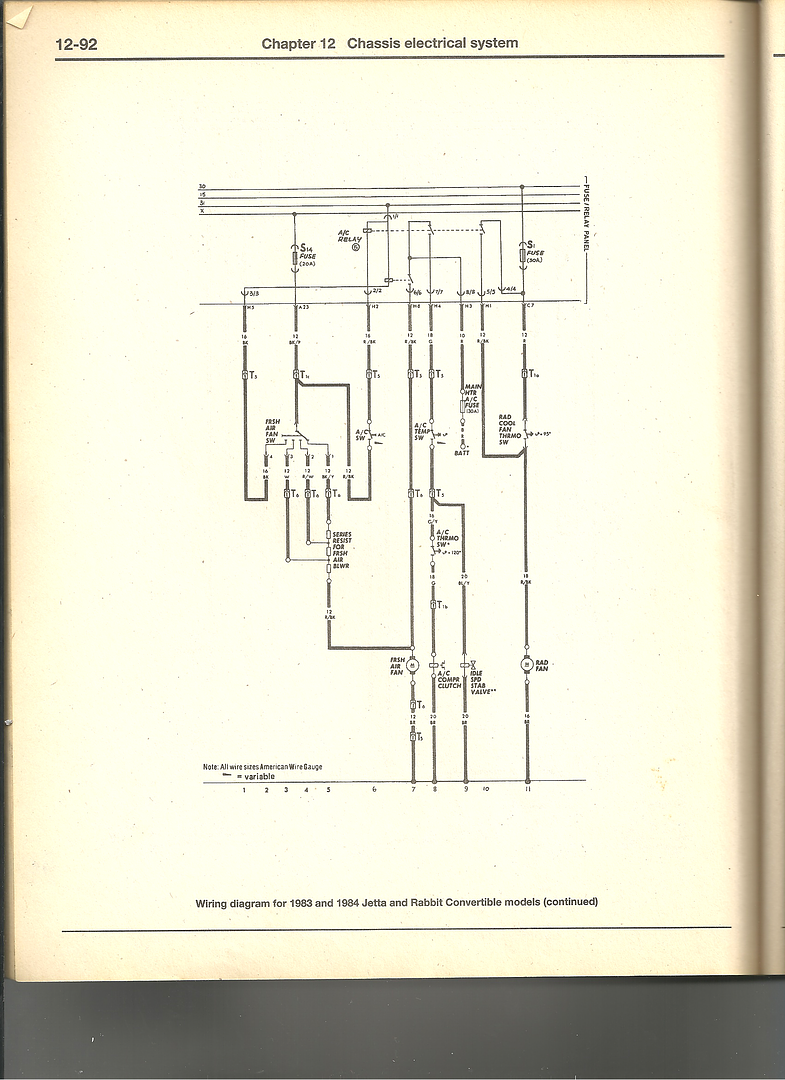
The above is a/c equipped cars, the radiator fan switch also acted as the "After Run" fan switch Simple is more better.
In the olden days of the first ittereation of fans that I saw, the fans had only a 12V source to them and used the BRASS and Copper
Radiators that were bolted to the frame from ground.
Not so with the advent of the plastic/aluminum radiators...You have to have a ground.
To accommodate the higher temp needs of a a/c equipped car, they added another speed to the fan, hence the 2 speed fan, as well as the
after run switch to prevent hot-starts and a iffy cooling of the engine when shut off.
The ideal thing would be to allow it to run based solely on the switches in the radiator.
Most of the after fan run are on the Low temp side of the switch in the radiator.
Now when the engine is running down the road, air flow over the radiator is sufficient usually to keep the car cool, however
if you run the a/c, it will run hotter, so they added a switch to the fan to turn it on, it is controlled by the heater control fan switch.
if the control selector is in the black area, on non-defrost, then the radiator fan operates as if the a/c isn't there. If the a/c is on, then it turns on the radiator fan. The Radiator fan will come on if you have the selector in the blue, or defrost setting.
When are driving at hi-way speeds, and you pull off the road, the engine temp spikes or rises, as it is trying to cool down, sort of like you after a run or exercise, need to "walk-it-off" or cool down. This engine spike is normal, but controlled by the cooling fans operation.
Now we have estabilished a few rules.
1. Radiator Shroud, and Radiator cards are necessasary for proper cooling and missing parts only decreases the
cooling ability of the system.
2. The fan needs 12V+ and a Ground to run.
3. The Primary fan switch is in the Radiator or, the after fan run switch if installed.
Lets do some checks.
Here is a simplified version of the 2 speed circuit and it's components.
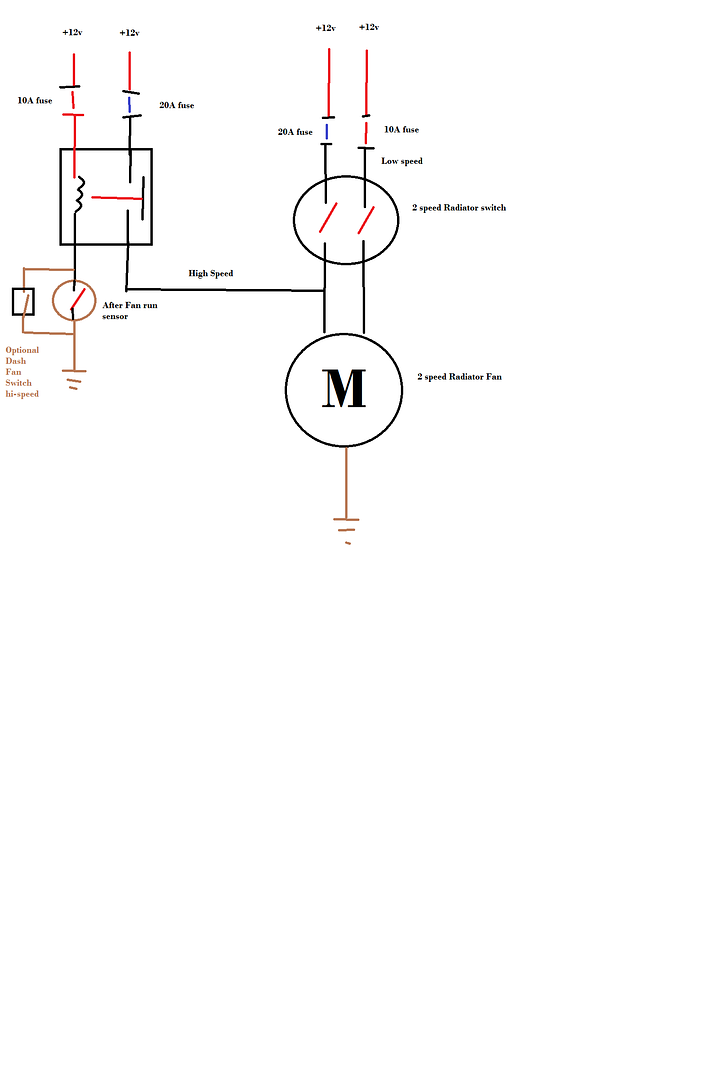
When the fan is running current flows from the ground on the motor back to 12V+
If your fan or car is running hotter than normal, you have to know where and what to test and why.
In the Bentley or Haynes manual you have to look closely at the circuits and then if you have a/c or not.
because if your car is equipped with a/c you have to look at the a/c schematics and not the normal ones.
a/c equipped even if you have had the a/c removed:
a/c equipped:
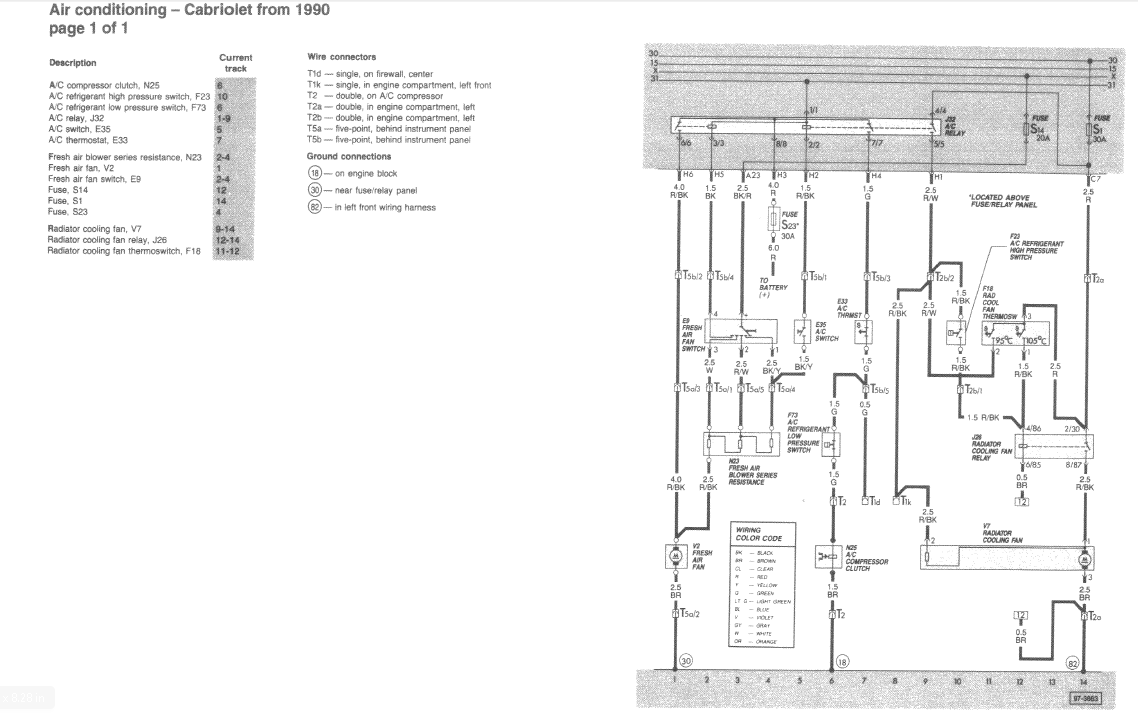
non-ac equipped:
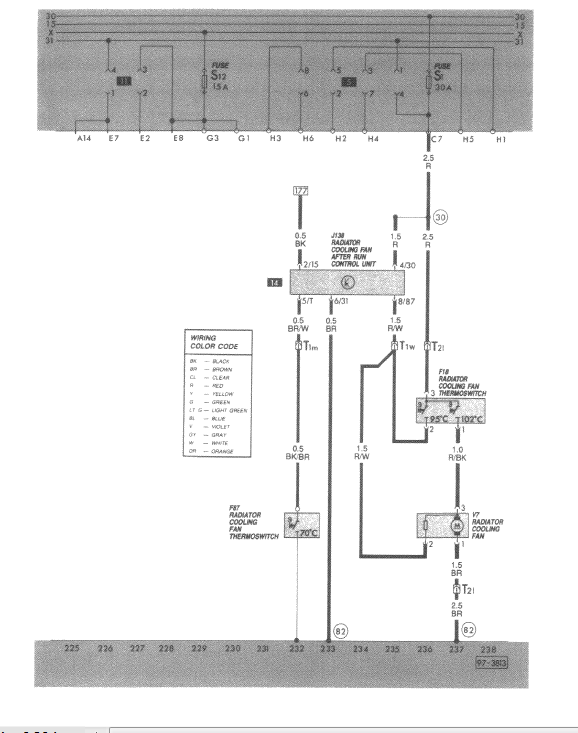
A little bit different, and now you know why when we ask does it have or had a/c?
Now that we know which schematics we should look at, lets get the basic trouble shooting steps.
Tools needed:
2 or 3 jumper wires with clips is best.
Digital VOM.
Does the fan run at all?
Well if it is a 2 speed fan does it run on both speeds?
Take the connector off the fan. look at the connector, There are 2 or 3 wires, depending on if there
is a single or dual speed fan. They are Brown, and RED/black, know the position of them relative to the fan motor.
On the fan Jumper the BROWN lead to ground
Keep your hands and wire jumpers clear of the fan blades.
Jumper 12V+ to the RED/BLK wire one at a time to +12V if the fan runs on both hi/low speed your fan is good.
Reconnect the connector, and now measure for a good ground via resistance to the Brown Plug or the Case of the fan.
0 or .5 ohms, then you are ok, infinite, then you better get a new ground.
Lets see if the fan works in all modes via the controls.
Fan switch to 0
Key in, and in the run position.
Turn the heater control sliders to the DEFROST setting, now turn the fan on, do you hear the a/c clutch pick, and the
fan start running in "HI-Speed"? yes or no.
If the Fan works in Hi, then we know it is the low speed side of things.
From the first test we know that the fan in general works.
On the Single speed fan, it is a little different, as there are fewer things to go wrong.
On a single speed fan or older circuit, you have but a FUSE, and a radiator switch and a motor.
Makes it way easier....
If the engine is up to temp, and your fan doesen't engage, Quickly measure for 12V+ to the motor to frame.
If the 12V+ is there, then you are missing the ground to the connector.
If the 12V+ isn't there, then we have to find out where it is missing.
The most common cause that I have seen for the 12V to go missing, on the 90ish's is the Relay on the inner fender near the battery.
this is a non-waterproofed relay that is subject to water spray, and battery outgassing.
If it goes bad, your radiator fan usually won't come on for normal operation, but will if the a/c is turned on.
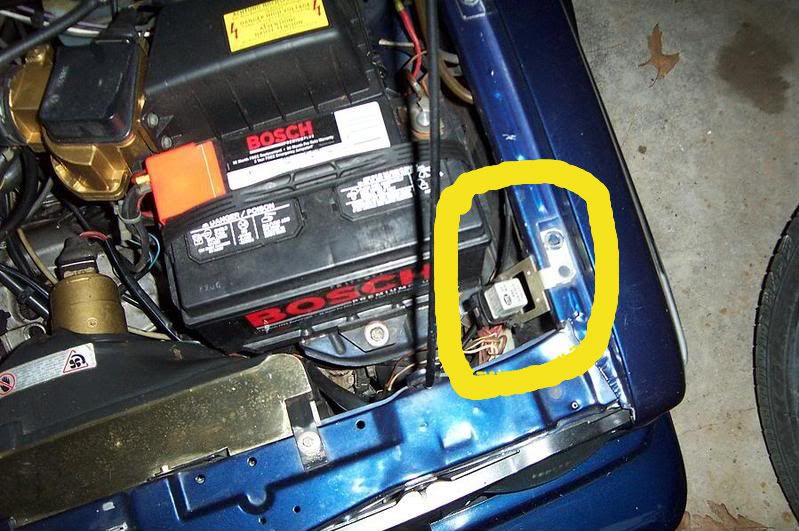
In the a/c circuit, you have F1 sending power to the low speed cooling relay (fender) and to the radiator switch.
In the a/c equipped car, f1 also sends 12V+ Through the a/c relay, then the radiator switch and to the radiator
fan relay (FENDER). as well as straight to the FAN.
So in reality if the Fan will turn on when the a/c is selected, you have validated everything in the circuit, save
for the low speed side of the Radiator switch.
If the Radiator fan doesn't come on at all when you turn on the a/c, then you are looking at the relay, or the
Radiator Fan thermo-switch.
To see the After Run circuit, this is where you have to refer to the normal schematics and not the a/c equipped ones.
But if the fan doesn't turn on after you have run the engine, then the quick test is to take the wire off the
after fan run switch (between the valve cover and the throttlebody, bolted to a bracket on the valve cover.).
This single wire attached, if you short that to ground, and your fan turns on, then your after-run circuts are
ok, if not replace the after run fan relay(controller). If your fan runs, then your after fan run switch is bad.
To test the Radiator fan thermo-switch you have to drain the cooling system, and remove the switch from the radiator.
Connecting the leads of your DVOM to the switch legs in resistance mode.
Using a non-flammable heat source, or a pan of boiling water, place the switches brass end into the water.
When it gets up to temp, it should "click" and measure 0 ohms resistance. Remove from the heat source and validate that it "clicks open when cool, then repeat for the "other" side if a 2 speed switch is installed. Also leave it in the water a bit to make sure that it isn't flaky and that it stays in the closed or 0 ohm mode...
Now if you have a lower temp thermostat installed, then your fan operation may be off or non-functional. If you are missing the t-stat, then all bets are off, as
your radiator is cooling all the time and the temperatures are not constant to operate the switches.
Radiator Cards or baffle templates:
http://www.cabby-info.com/Files/Baffles_All_AC.pdf
Thank you Kammy.
Trimming your radiator shroud:
http://volkswagenownersclub.com/vw/show ... tor-Shroud
Hope this settles things a bit for ya.
